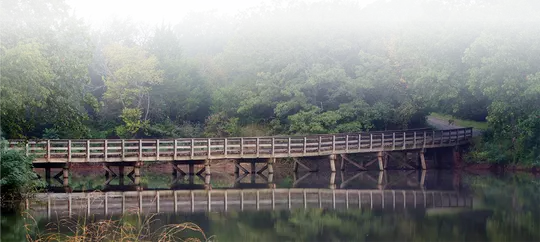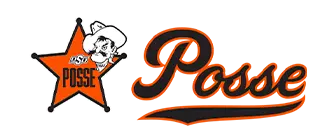Oklahoma State University Athletics
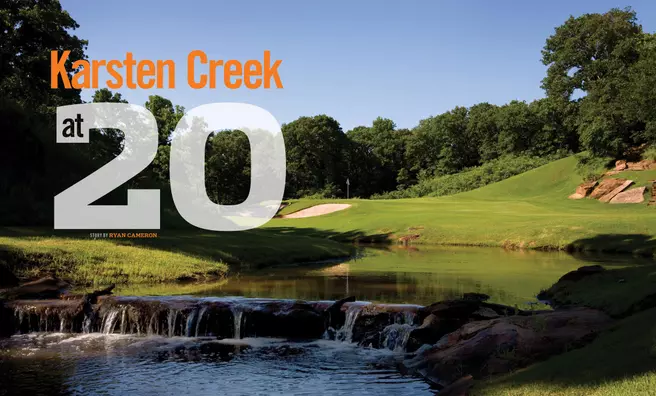
Karsten Creek at 20
By Ryan Cameron
for POSSE Magazine (Winter 2014)

Just as Rome was not build in a day, the Sistine Chapel was not painted overnight and the Panama Canal was more than a weekend project, so too was the masterpiece that is the home of Oklahoma State's golf program, Karsten Creek.
Developing a highly acclaimed golf course was a trying process requiring equal parts determination, generosity and imagination.
The end result of more than two decades of work was well worth it. Emerging from a dense plot of blackjack oak trees was a 7,400-yard layout considered one of the premier facilities in college athletics — in any sport.
While countless people played a crucial role in the creation of OSU’s crown jewel, three men were at the forefront of bringing Karsten Creek to life 20 years ago.
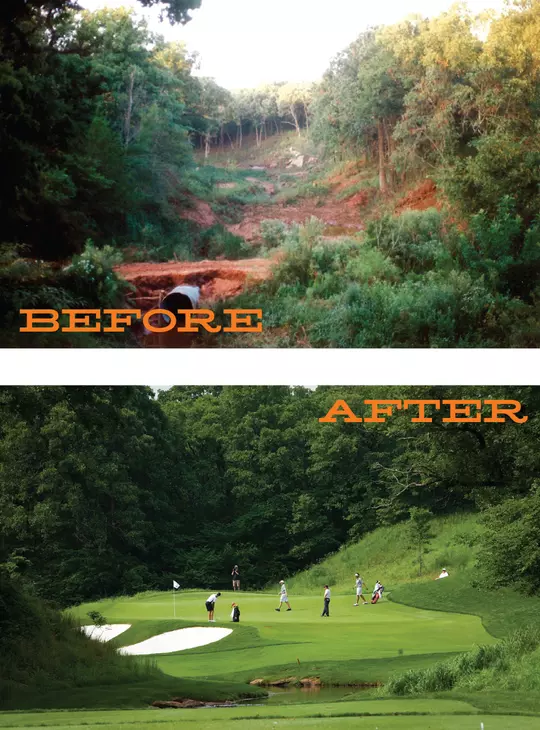
The Catalyst
A true visionary in the world of college golf, longtime OSU head coach Mike Holder identified early in his career the significant hurdles that had to be cleared in order to sustain a top-tier golf program in Stillwater. Population, weather and location were among the challenges that had to be addressed.
“It is hard enough to recruit in Oklahoma. There are three million people total in the state and you have that plus in Dallas or Houston or San Antonio alone. You are going to have to go out and compete and get them from other places. It is hard to get a kid to come out of the state of Texas and go north where the weather is worse and the wind blows like a son of a gun. Stillwater is off the beaten path and there’s not much else to do,” Holder stated matter-of-factly.
“There are a lot of negatives associated with it, so I had to try to offset that with something no one else had.”
What no one else had was a golf course primarily used by and controlled by the golf program. Holder’s line of thinking was to provide an edge in the most vital element of any team — recruiting.
“It all comes back to recruiting. Your team is only as good as the talent you can attract. My first month on the job I shared an office with Chet Bryan, who was the baseball coach. He had some advice for me, and I was all ears. He said, ‘I have been watching you and if you think that you are going to win championships based strictly on your ability to coach up talent, you are not going to have a very long career. Go out and recruit a bunch of thoroughbreds, and then just get out of the way.’ That is pretty good advice.” Holder said.
With that in mind, it was not in his shared office space with Bryan that the idea of Karsten Creek emerged, but rather a basement office across campus.
“That first year I was coach in 1973 I was teaching management in the college of business. They had an office in the basement, and my office mate was one of our golfers. He had done a scale model of a golf course just on the south side of Lake Carl Blackwell. It had all of the relief, trees and everything,” Holder said.
Not accustomed to seeing the foliage, ravines and creeks the model displayed, Holder’s interest was piqued.
“The next time I drove out on Highway 51, I made a point to glance over there north of the highway as I drove through the area. I had never really paid attention to it and thought it was beautiful and would be a great place for a golf course.”
Knowing his coach and the program’s founder, Labron Harris, had been responsible for building Lakeside Memorial Golf Course, Holder wanted to do that and more for his program.
“Coach Harris built Lakeside, and I thought maybe we could build a championship version of it someplace. That is where the idea came from. It just took me 20 to 21 years to find the place,” Holder said.
The location revealed itself in the late 1980s following a golf outing in Oklahoma City with OSU track and field coach Ralph Tate, athletics director Dick Young and Wiley T. McCollum. Holder had learned of a place across the highway from Lake Carl Blackwell known as Ham’s Lake, a locale of which, he learned on the ride home, Tate was very familiar.
A frequent fishing spot for Tate, he detoured the foursome’s return to Stillwater and arranged a boat tour of the lake, which confirmed Holder’s suspicion. He had discovered the future home of his golf sanctuary.
“As luck would have it, the university owned about three-fourths of the section and Lawrence Ham owned the northeast quarter. If we could buy that we could develop it and use the lot sales to help fund it. So that was the start. Dr. McCollum, who we played golf with that day, ended up being the guy that ended up buying the land for us,” Holder said.

The Namesake
The dream would have remained a fantasy without the means to bring it to life.
Enter Karsten Solheim.
The founder of Karsten Manufacturing, which produces PING golf equipment, found his company fledgling during the 1970s. Needing a jumpstart, Solheim sent Gary Hart to Stillwater in 1976 to meet with Holder in an attempt to get the nation’s premier program onboard with his product.
“They weren’t having any luck getting PGA Tour players to use their clubs. They were ugly. I say ugly because they were so radically different from what everyone else was playing and from what everyone else was manufacturing,” Holder said.
Unable to get his equipment in the hands of professionals, Solheim decided to target the tour’s future players while still at the collegiate level.
“He had the idea to go a step back and go get some good college players to use them and maybe get acceptance at the amateur level. Some of those good college players are going to play the tour, so maybe they will want to keep playing them,” Holder explained.
The sell was not easy, but by the early 1980s the Cowboys were PING-equipped, helping bring the program closer to the reality of having its own training ground via Holder’s relationship with Solheim.
“We were trying to build this golf course. I was talking to Gary Hart about it all the time. I thought it made sense that Karsten would give us some money. Finally, he mentioned that Karsten had never played Augusta National, so I thought maybe I could get him on because we had a friend, Bill Warren, who was a member. Bill said sure and hosted him,” Holder said.
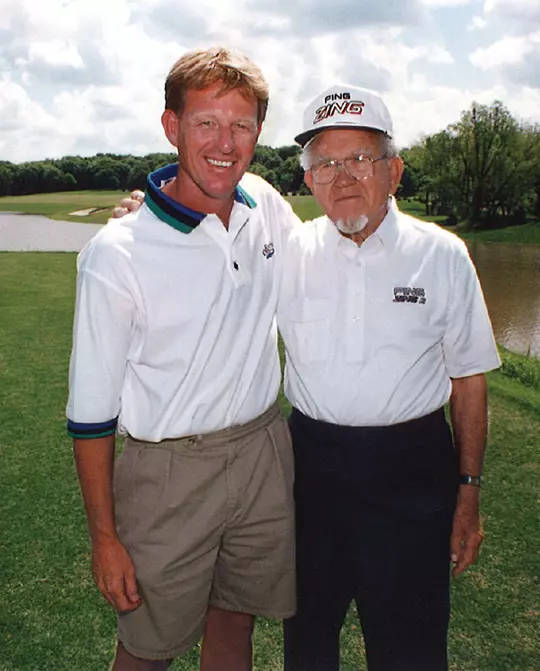
The trip to Augusta, coupled with a visit to the future site by Solheim, mixed in with Holder’s persistence, helped convince the course’s future namesake to get on board with the project.
“I can’t even remember how many years this had been going on. He called me one night, late, and said he was going to send some money for the golf course. I was thinking millions, but he said he would send half a million. It was more than I had, but it wasn’t what we needed. How do you sound excited and disappointed at the same time? He said he would send it in a week or so, and I waited and waited and waited,” Holder said.
The wait would prove to be more than worth it when Holder received an afternoon phone call from his wife, Robbie, which would lead to a rollercoaster of emotions.
“She called and told me FedEx just brought an envelope from Karsten. I rushed home, ripped it open and looked at it. I thought, ‘I can’t believe this. The guy only sent $100,000. He was supposed to send $500,000. Now what am I going to do?’
“Robbie asked to see the check and quickly corrected her husband’s miscalculation and bluntly revealed the good news.
“She said, ‘No, you dummy, it’s a million.’ I wasn’t used to looking at those big numbers. I called him up to let him know I got the money and that he made a mistake on that check and sent a million instead of a half million,” Holder said.
To which Solheim replied, “That isn’t a problem is it?”
The seven-figure check was not a problem, but a shot in the arm and just the first of several generous donations from Solheim and his family.
“They just kept giving a little bit more, and I still didn’t have enough to build it, and they kept giving a little bit more until we had enough to at least take a shot at it,” Holder said.
Having donated over $4 million toward the project, it is clear why the course bears his name.
“We wouldn’t have the golf course if it weren’t for him. I think his generosity and his equipment led to a lot of our success. It was a great partnership because I think we helped them sell a lot of golf clubs,” Holder said.
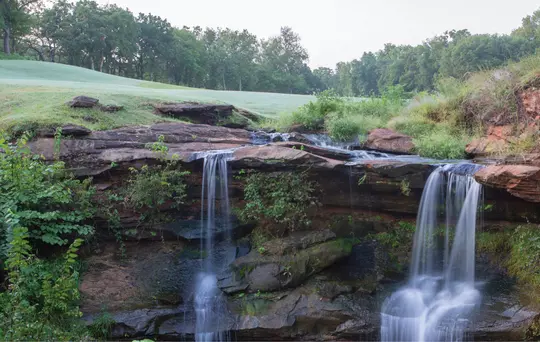
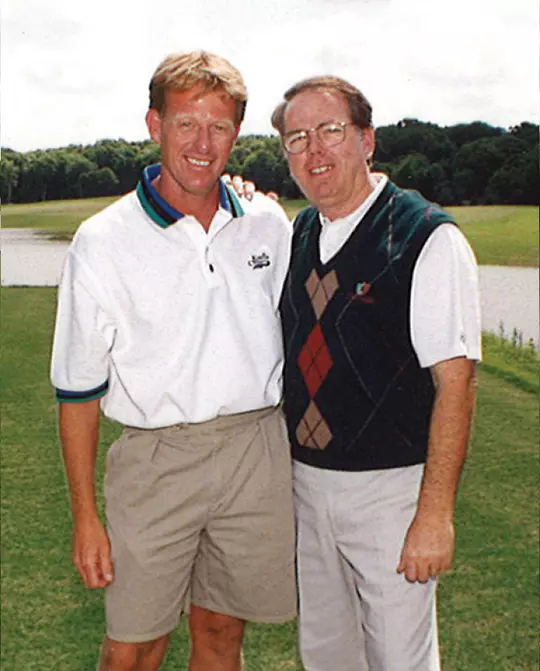
The Architect
By the early 1980s, the project was picking up momentum, prompting Holder to call on Joe Walser, a former Cowboy who had a hand in the construction of courses such as Oak Tree and PGA West, to help select a course designer.
A man by the name of Tom Fazio had caught Walser’s attention. Expressing immediate interest, Fazio made multiple trips to Stillwater at his own expense, providing Holder with his initial blueprint.
“He went back with his team and designed a golf course and gave us the plans to go out and raise money to build the course. He never charged me for any of that,” Holder said.
With an estimated cost of $3 million, Holder went to work seeking 18 hole donors at $150,000 apiece to secure the funds to begin moving dirt. However, the process proved easier said than done and took longer than initially intended.
“It seemed like I would sell a hole or two and get a donor, then they would have a reversal of fortune and fall by the wayside. There were probably 25 or 26 people at one time that said they would do a hole. By the time 1991-92 rolled around, $2.7 million wasn’t going to build a golf course and that is where the Solheims came in and really got us over the hump,” Holder said.
In the midst of Holder’s fundraising efforts, Fazio had ascended to the world’s No. 1 architect and now commanded a heftier fee.
“I really didn’t think there was any way to get him to do this. We interviewed a few other architects thinking this was probably what we were going to have to do. I remember calling him and telling him I thought we might have a chance to do this now, but we didn’t have a big budget like a lot of these places that he was working for now,” Holder said.
Once again, Fazio’s generosity and affection for the project kept him in the fold. After asking how much had been raised, he went to work tweaking the design he had concocted in an effort to become more cost effective.
“He said we had some things in that original routing that would be pretty expensive to build. So, he sent his team back here to walk the site again and see if he could massage the routing and maybe drop the cost. He still hadn’t committed to building it for us, and I didn’t know if I could afford his fee because he was probably getting $1-2 million a job,” Holder said.
With his services in demand, and in a position to pick and choose projects at his discretion, Fazio stayed on board at the bargain price of $400,000.
“He just liked the fact that we were persistent and had a dream. He liked the reasons that the golf course was being built,” Holder said.
Fazio’s terms were simple: No attorneys or contracts, but rather an old-fashioned handshake deal. He would deliver Holder’s golf course for not a penny more than what had been budgeted.
In return, all Holder had to do was pay his fee as well as the construction costs. “We shook hands and that was the deal. It was six months into the project before I ever got a bill from him for anything,” Holder said.
“He is quite a guy and the kind of person that you want to do business with. I have a lot of respect for Tom Fazio way beyond his ability as a golf architect.”
With the renowned designer on board, the two had to work through philosophical differences in the course’s design. Holder wanted the hardest golf course possible to challenge the best players, while Fazio took into consideration the average player seeking an enjoyable round of golf.
“I wanted to bring in difficulty and drama, and he was always trying to go the opposite direction. There are still holes out there today that if I had won in the discussion would look differently than they do,” Holder said.
In hindsight, Holder admits he may have lobbied harder to infuse more teeth into a track already known for its degree of difficulty.
“I think with what I know today I would have won a few more of those arguments because it is out here for the really, really good player. It is built for tournament golf, championship golf and it is probably not a golf course that the average player is going to enjoy no matter what. It is too difficult and too challenging even with the equipment of today. It can still bring you to your knees,” Holder said.
Fazio’s creation plays no favorites regardless of handicap, which mirrors the mentality used to operate the course.
“Everybody is treated equally. That is the thing the whole club is based on. Nobody gets a discount out here and no one gets a complimentary round. Everybody pays their share of the overhead from the green fee to a membership. Our golf team buys memberships just like everybody else out here. You just don’t give it away,” Holder said.
With that in mind, Holder engrained in his team an appreciation for the amount of hard work that made Karsten Creek a reality before a single Cowboy had played a shot on its Zoysia fairways.
On the Friday night before the first week of school in 1994, the head coach placed phone calls to his team with instructions to be in the course’s maintenance parking lot at 7 a.m. the next day.
“We get there and nobody was around. Fifteen minutes go by then you hear these trucks rumbling down the road. Three trucks pull in with sod pallets and behind them was Coach Holder. He just tells us to start walking down to 18. So we walk down to 18 and stand there in this dirt patch, and all of the sudden the tractors start delivering sod. From 8 o’clock until late that afternoon we laid sod. Probably three-quarters of the fairway and the left side of the rough,” recounted Brian Guetz, who now serves as the team’s assistant coach.
That day in August was not the way Guetz or his teammates imagined spending their time at Karsten Creek, but one that was not without its reward.
“I remember I was smart enough to eventually go down and sod the rough along the lake. You would roll out a roll of sod, jump in the lake to cool off then go get another one. He sent Leif Westerberg home early, because he had only been in town a couple of days from Sweden and had never seen temperatures over 85. Some people ask if that really happened, and yes it did. We helped clean up stuff on the first fairway one day, too. It is a good story, and you have a little sweat equity in it,” Guetz said.
The Windfall
Twenty years in and Karsten Creek has proven fruitful on the recruiting trail with the Cowboys being able to pluck the likes of budding stars Rickie Fowler, Peter Uihlein and Morgan Hoffmann and provide an ideal training ground for life as a professional.
When it came time to choose a school, Uihlein, a Florida resident, readily admits Karsten Creek was instrumental in his decision to leapfrog powerhouse programs closer to home.
“It was huge. Any time you can have a world-class facility in the palm of your hands, it is greatly beneficial. I personally felt it was the best place for me to hone my skills and get ready for the next level,” he explained.
Hoffmann echoed the sentiments of his former teammate with a strong endorsement of his own.
“I knew this was the place I could call home and use as a golf haven to get away from everything, which I really needed. It helped my game a lot. The three years I was here I got so much better, and it helped me get to the PGA Tour,” he said.
Fowler’s perspective on his college stomping grounds validates Holder’s vision for providing a golf course with the program serving as its top priority.
“Karsten Creek is one-of-a-kind when you look at it as far as it is the golf team’s course. You see other golf teams around the country have courses to practice at, but sometimes it is the university golf course. Sometimes they just have memberships. This is actually the Oklahoma State golf team’s golf course, and you are able to come out here and work on your game and be here on a daily basis,” Fowler said.
“As far as condition goes, it is probably one of the best-conditioned golf courses I have seen on a yearly basis. It was a great place for me to work on my game and be able to call home.”
Karsten Creek has proven so beneficial, the likes of LPGA standout Karin Sjödin and PGA performer Chris Tidland chose to put down roots in Stillwater, achieving another of Holder’s goals.
“It fused everything together,” Tidland said. “Coach Holder made it clear to me when it first opened. He told Alan (Bratton, now OSU’s men coach) and me he wanted guys to stay around here. Before that I hadn’t really thought about living here. Once it was open and we had access to a world-class practice area and golf course is when it first became an idea. It quickly became a reality when I turned pro. Karsten Creek was the thing that got us thinking about that. Our love for everything around here made the decision easy,” Tidland said.
“The cool thing about what Alan and I have been able to do is see it transform from truly the initial clear cutting to laying the sod to seeing the first day that the course was open to being able to play it before there was a clubhouse. And now being a part of the finished product,” Guetz said.
“We have seen the transformation and there’s only been a few people — Coach Holder, maybe a handful of donors, that have been around and seen what the last 20 years have entailed from the beginning to the end. It has been pretty cool to see that, and I can’t believe it has been 20 years.”
Not only has Karsten Creek helped propel its teams to success at OSU and beyond, it has helped inspire those Cowboys to pay it forward for the benefit of their alma mater.
“A lot of the principles we stand for are why our players are loyal and they do come back and they do give back. They support golf and they support the other sports here. I think that comes from the fact that all that we have is through the generosity of other people, and they understand that their role, once they use that to their advantage and go out into the world and made a living, is to give back and do the same thing and make it just as significant and just as great an experience for the next generation of OSU golfers,” Holder said.
“They are all-in for Oklahoma State University.”
